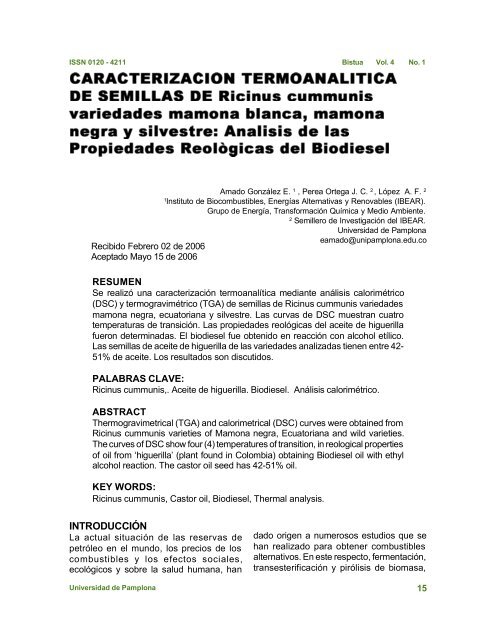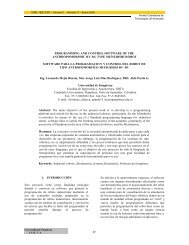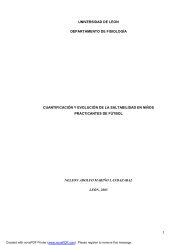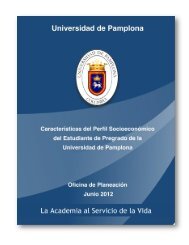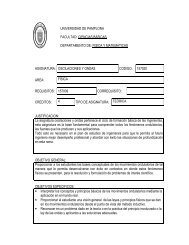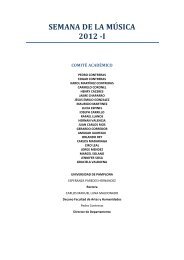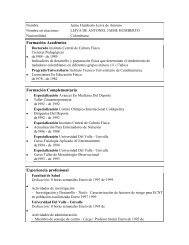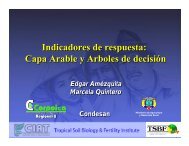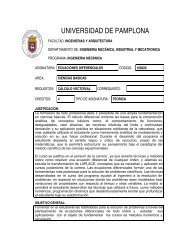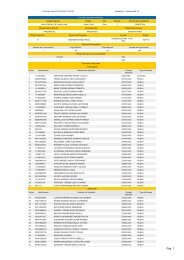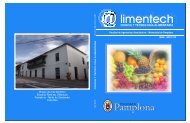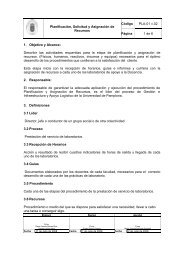INTRODUCCIÓN - Universidad de Pamplona
INTRODUCCIÓN - Universidad de Pamplona
INTRODUCCIÓN - Universidad de Pamplona
You also want an ePaper? Increase the reach of your titles
YUMPU automatically turns print PDFs into web optimized ePapers that Google loves.
ISSN 0120 - 4211 Bistua Vol. 4 No. 1<br />
Recibido Febrero 02 <strong>de</strong> 2006<br />
Aceptado Mayo 15 <strong>de</strong> 2006<br />
<strong>INTRODUCCIÓN</strong><br />
La actual situación <strong>de</strong> las reservas <strong>de</strong><br />
petróleo en el mundo, los precios <strong>de</strong> los<br />
combustibles y los efectos sociales,<br />
ecológicos y sobre la salud humana, han<br />
Amado González E. 1 , Perea Ortega J. C. 2 , López A. F. 2<br />
1 Instituto <strong>de</strong> Biocombustibles, Energías Alternativas y Renovables (IBEAR).<br />
Grupo <strong>de</strong> Energía, Transformación Química y Medio Ambiente.<br />
2 Semillero <strong>de</strong> Investigación <strong>de</strong>l IBEAR.<br />
<strong>Universidad</strong> <strong>de</strong> <strong>Pamplona</strong><br />
eamado@unipamplona.edu.co<br />
RESUMEN<br />
Se realizó una caracterización termoanalítica mediante análisis calorimétrico<br />
(DSC) y termogravimétrico (TGA) <strong>de</strong> semillas <strong>de</strong> Ricinus cummunis varieda<strong>de</strong>s<br />
mamona negra, ecuatoriana y silvestre. Las curvas <strong>de</strong> DSC muestran cuatro<br />
temperaturas <strong>de</strong> transición. Las propieda<strong>de</strong>s reológicas <strong>de</strong>l aceite <strong>de</strong> higuerilla<br />
fueron <strong>de</strong>terminadas. El biodiesel fue obtenido en reacción con alcohol etílico.<br />
Las semillas <strong>de</strong> aceite <strong>de</strong> higuerilla <strong>de</strong> las varieda<strong>de</strong>s analizadas tienen entre 42-<br />
51% <strong>de</strong> aceite. Los resultados son discutidos.<br />
PALABRAS CLAVE:<br />
Ricinus cummunis,. Aceite <strong>de</strong> higuerilla. Biodiesel. Análisis calorimétrico.<br />
ABSTRACT<br />
Thermogravimetrical (TGA) and calorimetrical (DSC) curves were obtained from<br />
Ricinus cummunis varieties of Mamona negra, Ecuatoriana and wild varieties.<br />
The curves of DSC show four (4) temperatures of transition, in reological properties<br />
of oil from ‘higuerilla’ (plant found in Colombia) obtaining Biodiesel oil with ethyl<br />
alcohol reaction. The castor oil seed has 42-51% oil.<br />
KEY WORDS:<br />
Ricinus cummunis, Castor oil, Biodiesel, Thermal analysis.<br />
dado origen a numerosos estudios que se<br />
han realizado para obtener combustibles<br />
alternativos. En este respecto, fermentación,<br />
transesterificación y pirólisis <strong>de</strong> biomasa,<br />
<strong>Universidad</strong> <strong>de</strong> <strong>Pamplona</strong> 15
Bistua Vol. 4 No. 1 ISSN 0120 - 4211<br />
<strong>de</strong>sperdicios industriales y domésticos, han<br />
sido propuestos como soluciones alternativas<br />
para suplir la <strong>de</strong>manda <strong>de</strong> energía y proteger el<br />
medio ambiente. Entre estos métodos, la<br />
Pirólisis parece ser una <strong>de</strong> las formas más<br />
eficiente y simple (D. Lima, et al., 2004)<br />
El interés en la investigación <strong>de</strong> los<br />
biocombustibles se pue<strong>de</strong> ver reflejado en el<br />
número <strong>de</strong> artículos y patentes que se han<br />
producido <strong>de</strong>s<strong>de</strong> el año 2.000 en Estados<br />
Unidos (26), Patentes corporativas (19) y Brasil<br />
(9)(A. Pinto, et al. 2005).<br />
El cultivo <strong>de</strong> Ricinus cummunis Lineo (familia<br />
Eurphorbiacae) resulta interesante tanto por la<br />
producción <strong>de</strong> aceite como por el uso <strong>de</strong> sus<br />
residuos lignocelulósicos ( A. Grigorio, G.<br />
Ntalos, 2001), y diversas aplicaciones a nivel<br />
industrial (A.S. Trevino, D.L. Trumbo, 2002).<br />
A nivel Nacional el cultivo <strong>de</strong> la higuerilla esta<br />
<strong>de</strong>ntro <strong>de</strong> los lineamientos <strong>de</strong> la firma <strong>de</strong>l<br />
Protocolo <strong>de</strong> Kyoto y las políticas<br />
implementadas por la Ley 99 <strong>de</strong> 1993 <strong>de</strong>l<br />
Ministerio <strong>de</strong>l Medio Ambiente, el Plan <strong>de</strong><br />
educación ambiental para el Departamento<br />
Norte <strong>de</strong> Santan<strong>de</strong>r 2002 - 2009 y el Plan <strong>de</strong><br />
Gestión Ambiental Regional 1997 - 2007<br />
[CORPONOR, 2001]<br />
En las últimas décadas las herramientas <strong>de</strong><br />
análisis térmico diferencial tales como la<br />
termogravimetría, el análisis térmico diferencial,<br />
etc, han adquirido gran importancia. Los datos<br />
obtenidos pue<strong>de</strong> dar información útil en relación<br />
con los mecanismos <strong>de</strong> reacción, parámetros<br />
cinéticos, estabilidad térmica, transformación<br />
<strong>de</strong> fase, calores <strong>de</strong> reacción, etc.<br />
Este trabajo utiliza las técnicas más mo<strong>de</strong>rnas<br />
<strong>de</strong> análisis calorimetríco y análisis físicoquímico<br />
en tres varieda<strong>de</strong>s <strong>de</strong> semillas <strong>de</strong> R.<br />
cummnunis .<br />
MATERIALES Y METODOS<br />
La metodología utilizada es para <strong>de</strong>nsidad<br />
16<br />
(ASTM D 4052), viscosidad (ASTM D 4052),<br />
contenido <strong>de</strong> azufre (ASTM D 4294) y<br />
purificación <strong>de</strong> los aceites (ASTM D 86). La<br />
extracción <strong>de</strong>l aceite <strong>de</strong> higuerilla se realizó<br />
<strong>de</strong> acuerdo al método <strong>de</strong> Soxhlet ( L. Seung-<br />
Koo, 1981;O. Karanta, A. Anusiem, 1996).<br />
Análisis Termogravimétrico. Una<br />
termobalanza (TGA Q600, TA Instruments) se<br />
utilizó.<br />
Una muestra <strong>de</strong> Aproximadamente 70 mg se<br />
colocó en la balanza a temperatura ambiente.<br />
Rampa 10.00 °C/min. Gas: Oxígeno.<br />
Figura 1.. Variedad mamona blanca o ecuatoriana<br />
blanca. Características 48% <strong>de</strong> aceite. Se cultiva<br />
<strong>de</strong>s<strong>de</strong> los 500 hasta los 1800 m snm .Tiempo <strong>de</strong><br />
cosecha 5 - 7 meses Cantidad por Hectárea: 2 a 5<br />
Kg.<br />
Figura 2. Variedad mamona negra. Características<br />
52% <strong>de</strong> aceite. Se cultiva <strong>de</strong>s<strong>de</strong> los 0 hasta los<br />
600 m snm. Tiempo <strong>de</strong> cosecha 4 - 5 meses.<br />
Cantidad por Hectárea: 2 a 4 Kg.<br />
<strong>Universidad</strong> <strong>de</strong> <strong>Pamplona</strong>
ISSN 0120 - 4211 Bistua Vol. 4 No. 1<br />
Figura 3. Variedad silvestre <strong>de</strong> R. cummunis<br />
proce<strong>de</strong>nte <strong>de</strong>l Brasil caracterizada por un<br />
producción perenne.<br />
Obtención <strong>de</strong>l Biodiesel. El aceite <strong>de</strong> higuerilla<br />
se convirtió en biodiesel mediante<br />
transesterificación alcalina con etanol al 20%<br />
en peso. Se utilizó hidróxido <strong>de</strong> potasio como<br />
catalizador disuelto en alcohol. La mezcla se<br />
calentó a 35 ºC bajo constante agitación por<br />
un tiempo <strong>de</strong> 30 min. La glicerina se separa<br />
mediante un proceso <strong>de</strong> <strong>de</strong>cantación. El<br />
biodiesel se purificó con un rendimiento <strong>de</strong><br />
89%.<br />
RESULTADOS Y DISCUSION<br />
1. Transesterificación<br />
El radio molar <strong>de</strong> alcohol-aceite más<br />
aceptado es 6:1 -30:1 ( A. Demirbas, 2003 ;<br />
E. Amado et al., 2005). La reacción (1) general<br />
<strong>de</strong> transesterificación es:<br />
´ ´´<br />
´´ ´<br />
RCOOR + R OH ⇔ RCOOR + R OH (1)<br />
El aceite <strong>de</strong> higuerilla se convirtió en biodiesel<br />
mediante transesterificación alcalina con<br />
etanol al 20% en peso. Se utilizó hidróxido <strong>de</strong><br />
potasio como catalizador disuelto en alcohol.<br />
La mezcla se calentó a 35 ºC bajo constante<br />
agitación por un tiempo <strong>de</strong> 30 min. La glicerina<br />
se separa mediante un proceso <strong>de</strong><br />
<strong>de</strong>cantación. El biodiesel se purificó con un<br />
rendimiento <strong>de</strong> 89%.<br />
2. Propieda<strong>de</strong>s Reológicas.<br />
En la tabla 1 se resumen la comparación <strong>de</strong><br />
las propieda<strong>de</strong>s fisicoquímicas <strong>de</strong>l aceite <strong>de</strong><br />
higuerilla frente a diesel y biodiesel.<br />
El alto valor <strong>de</strong> la viscosidad <strong>de</strong>l biodiesel<br />
obtenido a partir <strong>de</strong>l aceite <strong>de</strong> higuerilla<br />
comparado con el diesel es un obstáculo para<br />
su uso en motores. Sin embargo la necesidad<br />
<strong>de</strong> biocombustibles, obligará a realizar las<br />
modificaciones necesarias en el diseño <strong>de</strong><br />
los motores para utilizar todo tipo <strong>de</strong><br />
biocombustibles. De otra parte, la alta<br />
viscosidad pue<strong>de</strong> ser corregida mediante<br />
procesos <strong>de</strong> mezcla a diferentes<br />
proporciones con diesel a 5, 10. 15, 20 y 25<br />
%, don<strong>de</strong> la viscosidad aumenta con la<br />
proporción <strong>de</strong> biodiesel. (Conceicao, M., et<br />
al., 2005; S. Asadauskas, et al., 1997).<br />
El aceite <strong>de</strong> palma Elaeis sp. presenta<br />
diferencias notables en composición (ver<br />
Tabla 2) con el aceite <strong>de</strong> higuerilla,<br />
especialmente en relación el ácido ricinoleico,<br />
lo que le confiere sus características<br />
reológicas.<br />
Tabla 1. Comparación <strong>de</strong> propieda<strong>de</strong>s físico-químicas <strong>de</strong>l biodiesel obtenido a<br />
partir <strong>de</strong> las tres varieda<strong>de</strong>s <strong>de</strong> semillas <strong>de</strong> R. cummunis<br />
Característica (1) (2) (3)<br />
Densidad 20 C (g/cc) 0.9283 0.9272 0.9189<br />
Viscosidad 20 C (mm 2 /s) 13.76 13.65 13.61<br />
Azufre (%) 0 0 0<br />
(1) Variedad mamona blanca<br />
(2) Variedad mamona negra<br />
(3) Variedad silvestre<br />
<strong>Universidad</strong> <strong>de</strong> <strong>Pamplona</strong> 17
Bistua Vol. 4 No. 1 ISSN 0120 - 4211<br />
18<br />
Tabla 1. Comparación <strong>de</strong> la composición (%) ácidos grasos<br />
Aceite vegetal Palmítico Esteárico Oleico Linoleico Linolenico<br />
Ricinoleico<br />
Aceite <strong>de</strong> Palma 35 6 44 15 ------ -----<br />
Aceite <strong>de</strong> Higuerilla 2 3 5 2 ----- 88<br />
Fuente: D. Lima, et al., 2004<br />
Los grupos hidróxilo <strong>de</strong>l aceite <strong>de</strong> higuerilla son los responsables <strong>de</strong> sus propieda<strong>de</strong>s<br />
reológicas. Es <strong>de</strong>cir, su alta viscosidad relativa y gravedad específica, su solubilidad en alcohol<br />
en cualquier proporción y su limitada solubilidad en solventes alifáticos<br />
3. Análisis térmico.<br />
100<br />
90<br />
80<br />
70<br />
60<br />
50<br />
40<br />
30<br />
20<br />
10<br />
0<br />
Figura 4. Estructura <strong>de</strong>l ácido ricinoleico .<br />
50 150 250 350 450 550<br />
Temperatura (ºC)<br />
Mamona negra<br />
Mamona blanca<br />
Silvestre<br />
Figura 5. Curvas TG para las tres varieda<strong>de</strong>s <strong>de</strong> R. cummunis<br />
La Figura 5, muestra las curvas TGA <strong>de</strong> las tres varieda<strong>de</strong>s <strong>de</strong> R. cummunis presentan tres<br />
estados <strong>de</strong> aumento <strong>de</strong> masa claramente observables, los cuales son consecutivos y que<br />
podrían ser <strong>de</strong>bidos a la volatilización o <strong>de</strong>scomposición <strong>de</strong> los distintos aceites presentes,<br />
especialmente el aceite ricinoleico a temperaturas 205-336, 336-440 y 440-550 ºC con las<br />
respectivas pérdidas <strong>de</strong> masa 33%, 72% y 97%..<br />
<strong>Universidad</strong> <strong>de</strong> <strong>Pamplona</strong>
ISSN 0120 - 4211 Bistua Vol. 4 No. 1<br />
180<br />
160<br />
140<br />
120<br />
100<br />
80<br />
60<br />
40<br />
20<br />
Mamona negra<br />
Mamona blanca<br />
Silvestre<br />
A<br />
0<br />
50 1 5 0 250 350 450 550<br />
Temperatura (ºC)<br />
lFigura 6. DSC para las tres varieda<strong>de</strong>s <strong>de</strong> R. cummunis<br />
La Figura 6, muestra las curvas DSC para las tres varieda<strong>de</strong>s <strong>de</strong> R. cummunis con cuatro<br />
transiciones exotérmicas atribuidas a los procesos <strong>de</strong> <strong>de</strong>scomposición <strong>de</strong> los aceites (ver<br />
Tabla 2)<br />
Tabla 2. Temperatura <strong>de</strong> transición y entalpías correspondientes para las tres va-<br />
rieda<strong>de</strong>s <strong>de</strong> H. cummunis.<br />
Variedad A B C D<br />
<strong>Universidad</strong> <strong>de</strong> <strong>Pamplona</strong> 19<br />
B<br />
C<br />
ºC J/g ºC J/g ºC J/g ºC J/g<br />
________________________________________________________________________________<br />
Mamona negra 252 194 334 339 402 1027 493 3600<br />
Mamona blanca 252 161 335 286 403 597 510 3708<br />
Silvestre 253 149 341 335 400 946 505 4941<br />
La capacidad calorífica <strong>de</strong> las semillas <strong>de</strong> H.<br />
cummunis en el intervalo <strong>de</strong> 254-509 ºC fue<br />
<strong>de</strong> 6.05 -15.32 J/gK. Estos valores sugieren<br />
que el aceite <strong>de</strong> higuerilla tiene una capacidad<br />
mayor <strong>de</strong> transferencia <strong>de</strong> calor en<br />
comparación con los biodiesels.<br />
CONCLUSION<br />
Las propieda<strong>de</strong>s reológicas como viscosidad<br />
D<br />
y <strong>de</strong>nsidad <strong>de</strong>l aceite <strong>de</strong> higuerilla están<br />
afectadas por la presencia <strong>de</strong> grupos<br />
hidroxiácidos. El proceso <strong>de</strong><br />
transesterificación se pue<strong>de</strong> realizar con<br />
excelentes resultados utilizando etanol a<br />
condiciones ambiente.<br />
Las curvas <strong>de</strong> TGA sugieren tres procesos<br />
<strong>de</strong> aumento <strong>de</strong> masa importantes. Mientras
Bistua Vol. 4 No. 1 ISSN 0120 - 4211<br />
que las curvas <strong>de</strong> DSC presentan cuatro<br />
temperaturas <strong>de</strong> transición observables.<br />
Los altos valores <strong>de</strong> entalpía <strong>de</strong> la variedad<br />
silvestre podrían sugerir su utilización en<br />
procesos <strong>de</strong> combustión abierta sin la<br />
presencia <strong>de</strong> compuestos con presencia <strong>de</strong><br />
azufre en vez <strong>de</strong> carbón u otros materiales<br />
20<br />
<strong>de</strong> origen lignocelulósicos. .<br />
AGRADECIMIENTOS<br />
El autor agra<strong>de</strong>ce la colaboración <strong>de</strong><br />
Sercoagro Ltda., por el material <strong>de</strong> semillas<br />
facilitado, a la <strong>Universidad</strong> <strong>de</strong><br />
<strong>Pamplona</strong> por su financiación.<br />
REFERENCIAS BIBLIOGRAFICAS<br />
Amado, E. Villamizar, A., Gáfaro, A. Evaluación <strong>de</strong> procesos <strong>de</strong> producción <strong>de</strong> biodiesel<br />
a partir <strong>de</strong> grasa amarillas con altos contenidos <strong>de</strong> ácidos grasos libres. Bistua. 2005,<br />
3(1): 54-60.<br />
Asadauskas, S., Peréz, J., Duda L. Lubrication propierties of castor oil –potential<br />
basestock for bio<strong>de</strong>gradable lubrication. Lubrication Eng. 1997, 53, 35-40.<br />
Conceiçao, M., Can<strong>de</strong>ia, R., Dantas, H., Soleda<strong>de</strong>, L., Fernan<strong>de</strong>z, V., Souza, A. Rheological<br />
Behavior of castor oil biodiesel. Energy and Fuels. 2005, 19, 2185-2188.<br />
CORPONOR. Plan <strong>de</strong> educación ambiental para el <strong>de</strong>partamento Norte <strong>de</strong> Santan<strong>de</strong>r<br />
2002 – 2009. Cúcuta, 2004.<br />
Demirbas, A. Biodiesel fuels from vegetable iols via catalytic and non-catalytic supercritical<br />
alcohol transesterifications and other methods: a survey. Energy Conversion and<br />
Management. 2003, 44, 2093-2109.<br />
Grigoriou, A., Ntalos, G. The Potential use of Ricinus communis L. (Castor) stalks as a<br />
lignocellulosic resource of particleboards. Industrial Crops and Products. 2001, 13, 209-<br />
218.<br />
Karanta, O., Anusiem, A.A bioresource solvent for extraction of castor oil. Industrial Crops<br />
and Products. 1996, 5, 273-277.<br />
Lima, D., Soares, V., Ribeiro, E., Carvalho,D., Cardoso, E., Rassi, F., Mundim, K.,<br />
Rubim, J., Suarez, P., Diesel like fuel obtained by pyrolysis of vegetables oils. J.Anal.Appl.<br />
Pyrolysis. 2004,71, 987-996.<br />
Pinto, A., Guarieiro, L., Rezen<strong>de</strong>, M., Ribeiro, N., Torres, E., Lopes, W., Pereira, P.,<br />
Andra<strong>de</strong>, J. J. Braz.Chem.Soc., 2005,1, 2-17.<br />
Seung-Koo, L. Methods for percent oil analysis of avocado fruit. California Avocado Society.<br />
1981, 65, 133-141.<br />
Trevino, A., Trumbo, L. Acetoacetylated castor oil in coatings applications Progress in<br />
Organic Coatings 44 (2002) 49–54<br />
<strong>Universidad</strong> <strong>de</strong> <strong>Pamplona</strong>


